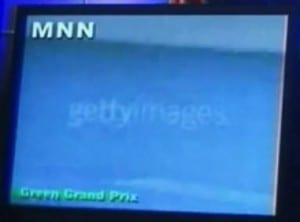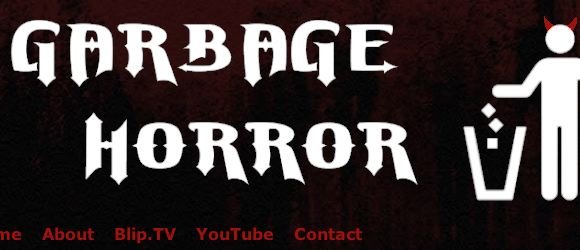Copyright Challenges in Creating Garbage Horror
 Like most really crazy ideas, it started as a conversation over dinner. While at a restaurant, my significant other, Crystal, and I began talking about our mutual love for horror movies, in particular low-budget ones, and wishing that we could do something more with it, whether for fun or as a whole new project.
Like most really crazy ideas, it started as a conversation over dinner. While at a restaurant, my significant other, Crystal, and I began talking about our mutual love for horror movies, in particular low-budget ones, and wishing that we could do something more with it, whether for fun or as a whole new project.
Since we were also long-time fans of other review series like The Angry Video Game Nerd, the Nostalgia Critic and The Cinema Snob, the idea began to float toward doing our own review series, targeting these specific movies.
That show quickly became Garbage Horror.
It was going to be a steep learning curve for us. Neither of us had done any significant video work (no video editing experience at all) and we had no idea what the format and general structure of the show would be like.
But one area I didn’t expect any problems was the area of copyright. However, I quickly learned that I was very, very wrong. The change in medium brought a slew of new copyright challenges and overcoming them, in many ways, helped to define what our show would become and what we could do with it.
With that in mind, here is some of the copyright challenges we faced and how we overcame them. It wasn’t an easy road, but so far it’s been one well worth taking.
Getting the Series Started
 When we first started drafting the show format, we knew two things. First, we wanted to do something different and, second, we wanted to respect the copyright of the filmmakers we were reviewing.
When we first started drafting the show format, we knew two things. First, we wanted to do something different and, second, we wanted to respect the copyright of the filmmakers we were reviewing.
The two were related considering that the review shows we enjoy typically follow a long review format that rely on showing clips from the film, describing the whole plot and making fun of the movie the entire time. This has lead to at least one copyright controversy over their reviews.
Seeking to avoid that, or at least reduce the likelihood of it, we decided on a two-part format for the episodes.
- Parody Intro: The first 1-2 minutes would be a parody intro of a scene from the movie, either one that was ridiculous or one we thought we could “improve” with our zero-budget filmmaking.
- The Review: The actual review portion would be 10-12 minutes (average) and would be an actual discussion of the film with overlays.
The parody intro would be short and, generally, use no actual footage from the movie (the exception being the “Monster Dog” intro where we used a clip from a song to recreate a music video in the movie). Just our parodying of something from the film with our own work. Though there could be a derivative works issue, considering the remakes are all parody we felt comfortable with our fair use position as long as we were careful.
The review portions, would be spoiler-free and not give away anything that happens aftter the second act. There would be a plot synopsis of the film up to that point and then be a discussion between us about the good and bad of the movie. Clips would be used, though none would be longer than a minute and they would only have sound if it was crucial to the point.
All in all, we felt that the structure of the reviews gave us a much stronger fair use argument than many of the shows we enjoy and, more importantly, would actually encourage people to go out and buy the movies we watched (at least the good ones) by not giving away the ending or anything too central to the plot.
However, as we found out quickly, our copyright troubles were just beginning and the worst was yet to come.
Building the Show
 Once we had the basic premise of the show, we had the challenge of building our first episode. However, that turned out to be a greater challenge than expected.
Once we had the basic premise of the show, we had the challenge of building our first episode. However, that turned out to be a greater challenge than expected.
The most immediate problem was obtaining the clips themselves. Though DVD ripping was made legal by the most recent round exemptions passed to the DMCA’s anti-circumvention rules, many of the movies we were watching weren’t available (to us) on DVD.
Many were on Netflix for digital streaming and the law offers no way to legally circumvent that DRM and, even if it did, Netflix’s terms of use expressly forbids it. So, an alternative had to be found.
Fortunately, the screen capture software I use, Snapz Pro X does remarkably well with video recordings. The system doesn’t circumvent DRM, merely captures what’s on screen after Netflix handles the decryption, making the process legal from the DMCA side but also within the bounds of Netflix terms, which only bars this for infringing activities.
However, the system doesn’t work for long clips, especially with sound, as it begins to slow down and, if you’re using sound, audio falls out of sync quickly. Still, for the purpose of short, usually sound-less clips, it works very well. It’s also worth noting that, since OSX Lion, it doesn’t work for capturing video in iTunes as iTunes simply whites out the screen when you try to do so.
The other challenge was music. Though there’s no shortage of good CC-licenseable music available, CCMixter being my favorite site, searching for music is a disorganized mess at times. Though we’ve used a variety of artists over our nine episodes, we ended up just agreeing to first check and see if Pitx has a song we can use.
Pitx, as many of you know, did the theme for the Copyright 2.0 Show and he also does a wide variety of music, ranging from blues to rock to more classical works we’ve used in the show.
With those issues resolved, it was pretty easy to start assembling our episodes. However, on our seventh episode we ran into a copyright problem we honestly did not expect.
Birdemic and The Getty Logo
 When preparing to record our seventh episode, which was to be on the ultra-low-budget bird attack/global warming caution piece Birdemic, I noticed something unusual during a scene in the first part of the movie.
When preparing to record our seventh episode, which was to be on the ultra-low-budget bird attack/global warming caution piece Birdemic, I noticed something unusual during a scene in the first part of the movie.
The scene had the lead character “Rod” watching a news report about an environmentally-friendly auto race. As the news anchor talked awkwardly over what was clearly stock footage of F1 cars, I noticed something peculiar, the Getty Images logo.
Usually, that’s a sign that the person using the content didn’t pay to license the image/video and simply captured the clips from the site. However, I had no way to be certain so I decided to contact Getty Images and let them know about the use and let them investigate. I did so via their live chat the day after I noticed the presence of the logo.
I haven’t heard anything further about the matter, nor do I necessarily expect to, especially considering that I’ve written some very critical things about Getty in the past.
Still, it was amazing to see a Getty Images logo over stock video in a movie I was watching in Netflix. It was made even worse by just how unnecessary the scene actually was.
Bottom Line
In the end, making a video series that respects copyright was a big challenge, perhaps a lot bigger than it had to be. A lot of the obstacles seemed artificial to me, especially the DRM issues. While I could understand why the protections were there, there were many advertised systems that could have trivially broken the DRM schemes (at least they claimed to) but we avoided because they were illegal.
In the end, our show still stinks but it’s not because copyright got in the way. Yes, it was an added challenge in places, but not one we couldn’t overcome. No, our show stinks because A) It’s intentionally bad in places and B) We have a lot to learn and need some new equipment.
Still, the show and it’s first nine episodes have been a lot of fun. I’m looking forward to shooting the next ten and dealing with challenges may come with the territory.
Want to Reuse or Republish this Content?
If you want to feature this article in your site, classroom or elsewhere, just let us know! We usually grant permission within 24 hours.
